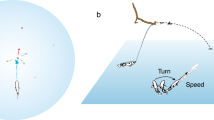Summary
-
1.
An experimentally blinded crayfish (Cherax destructor) attacks an object that briefly touches the flagellum of its second antenna. Since there is no feedback control during the attack, the entire motor command has to be preprogrammed immediately after stimulation.
-
2.
I studied the dynamics of the attacks by video film analysis and by decomposing the motion of the body into rotation around a centre on the long axis of the body and a translation parallel to it. The time course of both rotation and translation velocities can be fitted by pulse responses of third order low pass filters.
-
3.
It is shown that the model of Zeil et al. (1985) to describe the attacks is adequate only, when the distancedA of the point of stimulation from the base of the antenna is short. For longer distances it predicts an insufficient rotation, and a translation larger than required. The discrepancy is traced back to the fact that crayfish simultaneously translate and rotate during an attack.
-
4.
To program a successful attack the crayfish have the option to adjust the extent of rotationaw and that of the translationav, as well as the ratio of their time constants. They fit bothaw andav todA but do not vary the time constants.
-
5.
It is demonstrated that for the purpose of motion analysis a centre of rotation and a translation velocity component orthogonal to the body long axis cannot be derived unequivocally. One of them has to be chosen arbitrarily.
-
6.
The peculiarities of the crayfish' attack as compared with prey catching strategies in other animals, and the limits of single frame analysis regarding conclusions about neural events are discussed.
Similar content being viewed by others
References
Bender M, Gnatzy W, Tautz J (1984) The antennal feathered hairs in the crayfish: a non-innervated stimulus transmitting system. J Comp Physiol A 154:45–47
Copp NH, Watson D (1988) Visual control of turning responses to tactile stimuli in the crayfishProcambarus clarkii. J Comp Physiol A 163: 175–186
Melchers M (1967) Der Beutefang vonCupiennius salei Keyserling (Ctenidae). Z Morphol ökol Tiere 58:321–346
Rossel S (1980) Foveal fixation and tracking in the praying mantis. J Comp Physiol 139:307–331
Sandeman DC (1985) Crayfish antennae as tactile organs: their mobility and the responses of their proprioceptors to displacement. J Comp Physiol A 157:363–373
Sandeman DC, Sandeman RE (1984) Crayfish antennae: a sophisticated tactile sensory system. Proc Aust Physiol Pharmacol Soc 15:194P
Sandeman DC, Varjú D (1988) A behavioural study of tactile localization in the crayfishCherax destructor. J Comp Physiol A 163:525–536
Schneider D (1954) Beitrag zu einer Analyse des Beuteund Fluchtverhaltens einheimischer Anuren. Biol Zbl 73:225–282
Tautz J (1987) Water vibration elicits antennal movements in the crayfish,Orconectes limosus. Anim Behav 35:748–754
Tautz J, Masters WM, Aicher B, Markl H (1981) A new type of water vibration receptor on the crayfish antenna. I. Sensory physiology. J Comp Physiol 144:533–541
Taylor RC (1975) Physical and physiological properties of the crayfish antennal flagellum. J Neurobiol 6:501–519
Varjú D (1977) Systemtheorie für Biologen und Mediziner. Springer, Berlin Heidelberg New York
Zeil J, Sandeman R, Sandeman D (1985) Tactile localisation: the function of active antennal movements in the crayfishCherax destructor. J Comp Physiol A 157:607–617
Author information
Authors and Affiliations
Rights and permissions
About this article
Cite this article
Varjú, D. Prey attack in crayfish: conditions for success and kinematics of body motion. J. Comp. Physiol. 165, 99–107 (1989). https://doi.org/10.1007/BF00613803
Accepted:
Issue Date:
DOI: https://doi.org/10.1007/BF00613803




